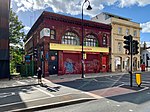Kentish Town West railway station
DfT Category E stationsFormer London and North Western Railway stationsKentish TownLondon stations without latest usage statistics 1415London stations without latest usage statistics 1516 ... and 7 more
Rail transport stations in London fare zone 2Railway stations in Great Britain closed in 1971Railway stations in Great Britain opened in 1867Railway stations in Great Britain opened in 1981Railway stations in the London Borough of CamdenRailway stations served by London OvergroundUse British English from August 2012

Kentish Town West railway station, on the North London line, is in Prince of Wales Road in the London Borough of Camden. It is in Travelcard Zone 2. The station and all trains serving it are operated by London Overground.
Excerpt from the Wikipedia article Kentish Town West railway station (License: CC BY-SA 3.0, Authors, Images).Kentish Town West railway station
Wilkin Street Mews, London Kentish Town (London Borough of Camden)
Geographical coordinates (GPS) Address Nearby Places Show on map
Geographical coordinates (GPS)
| Latitude | Longitude |
|---|---|
| N 51.5468 ° | E -0.1468 ° |
Address
Kentish Town West Railway Station
Wilkin Street Mews
NW5 3NN London, Kentish Town (London Borough of Camden)
England, United Kingdom
Open on Google Maps









